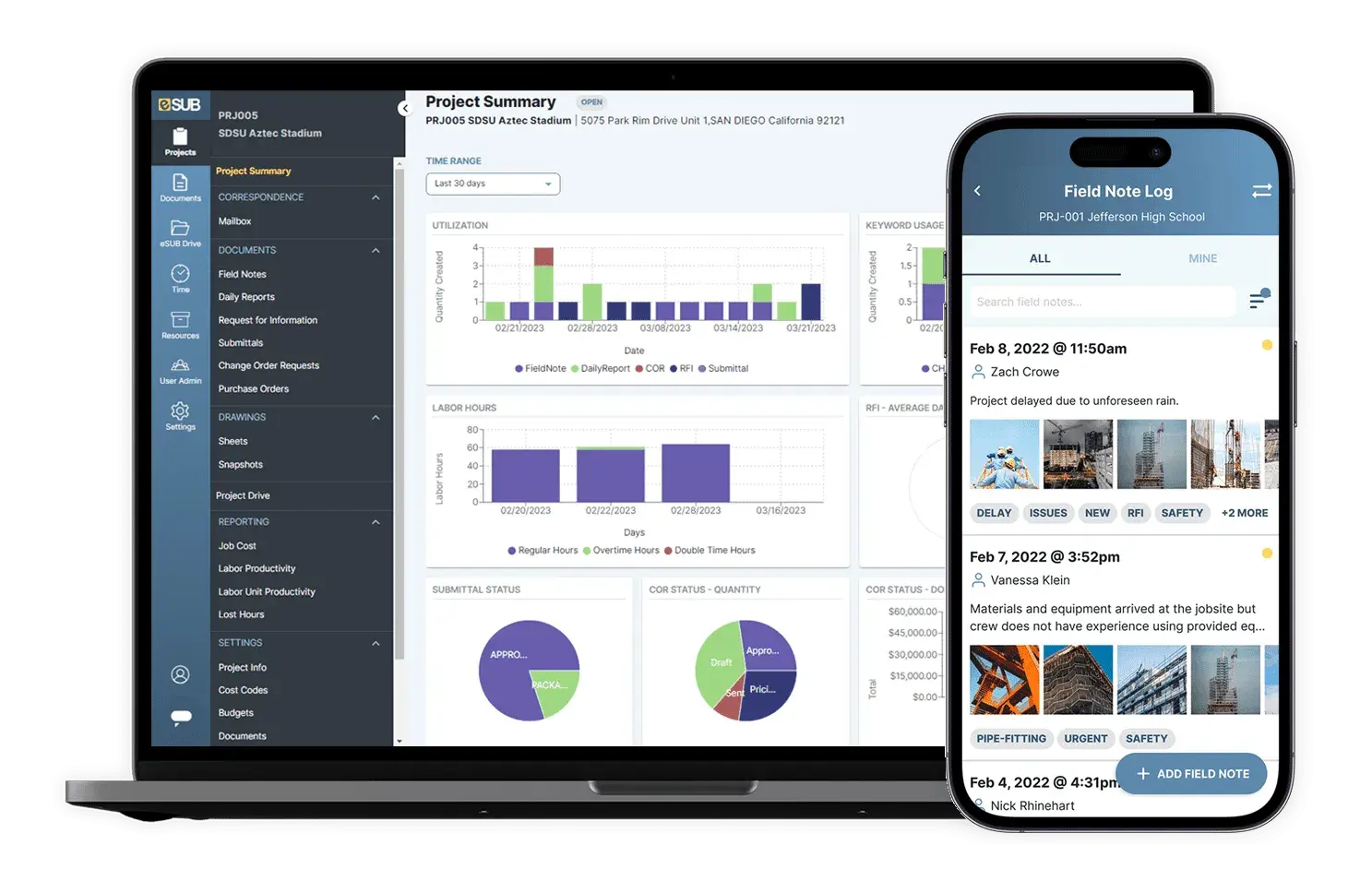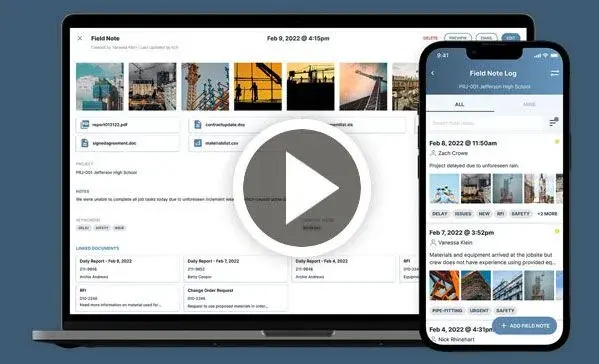
A 10-Step Guide to Better Construction Document Organization (and Why it Matters)
In a fast-paced, chaotic industry like commercial construction, subcontractors need to stay on top of their game. One critical aspect of achieving success is organizing construction documents effectively.
Organizing construction documents is essential for effective project management, communication, and collaboration among stakeholders. Proper organization ensures that vital information is easily accessible, reducing the potential for errors, miscommunications, and delays.
Here is our step-by-step guide on how to organize construction documents:
1. Create a clear file structure:
Start by setting up a consistent and logical folder structure that is easy to navigate. This structure should include separate folders for different types of documents, such as design drawings, specifications, contracts, permits, reports, and correspondence.
Example folder structure:
- ProjectName/
- Drawings/
- Specifications/
- Contracts/
- Permits/
- Reports/
- Correspondence/
2. Use a consistent naming convention:
Establish a standard naming convention for all files and folders, including information like the document type, version or revision number, and date. This will make it easier to locate and identify specific documents.
Example naming convention:
- DocumentType_ProjectName_Version_YYYYMMDD
3. Utilize document management software:
Consider using construction document management software to streamline the process of organizing, sharing, and tracking documents. Such software often includes features like version control, cloud storage, and access controls for increased security and efficiency.
4. Implement version control:
Keep track of document revisions and updates by incorporating version control. This can be done through document management software or by maintaining a version history within the file itself.
5. Establish access controls:
Ensure that only authorized personnel can access sensitive or confidential documents by implementing password protection or access controls. This can help prevent unauthorized changes and maintain document integrity.
6. Keep a master index:
Maintain a master index of all documents, including their names, descriptions, revision numbers, and associated dates. Update this index whenever a document is added, revised, or removed.
7. Regularly back up documents:
Protect your construction documents by regularly backing them up to a secure location, such as an external hard drive or cloud storage. This ensures you have a backup copy in case of data loss or corruption.
8. Archive completed projects:
Once a project is completed, archive the associated documents to a separate location for future reference or compliance purposes. Be sure to maintain the organization and naming conventions in the archive.
9. Communicate with stakeholders:
Clearly communicate the organization system and expectations with all project stakeholders, including architects, engineers, contractors, and clients. This helps ensure that everyone is on the same page and using the same system for managing documents.
10. Review and update:
Regularly review your document organization process and make any necessary updates to improve efficiency or address changes in project requirements or industry best practices.
Effective organization of project documents is a game-changer for subcontractors. A well-structured documentation system not only streamlines communication and decision-making but also helps manage risks and ensures compliance with regulations. In this section, we’ll outline the reasons why organizing construction documents is essential for commercial subcontractors.
Organizing your construction documents improves communication and collaboration. A well-organized documentation system makes it easier for all project stakeholders to access and share vital information. This fosters better communication and collaboration, leading to successful project execution.
It will reduce errors and rework.
Rework is the bane of many subcontractors’ existence. By properly organizing your construction documents, you can significantly reduce errors and misunderstandings, saving time, money, and resources. This streamlined approach helps prevent the dreaded rework that plagues many subcontractors.
You’ll streamline your decision-making.
When documents are organized and easily accessible, project stakeholders can make informed decisions more quickly. This improves project efficiency and keeps schedules on track.
It helps with risk management.
Proper organization of construction documents allows subcontractors to better identify and manage potential risks, preventing costly delays or disputes.
It ensures compliance with regulations and contracts.
Properly organized documentation helps subcontractors ensure they are complying with strict regulatory requirements and contractual obligations, reducing the risk of penalties or legal issues.
It improves productivity.
An organized documentation system allows subcontractors to spend less time searching for documents and more time focusing on their core tasks, ultimately enhancing productivity and project performance.
It provides tools for better dispute resolution.
In the event of disputes or claims, well-organized construction documents can serve as critical evidence to support a subcontractor’s position, making it easier to resolve disputes and avoid costly litigation.
It enables easier project handover.
Proper organization of construction documents simplifies the process of handing over project information to clients, facility managers, or other stakeholders at the end of a project, ensuring a smoother transition and reducing post-construction issues.
It boosts your professionalism.
A well-organized documentation system demonstrates a subcontractor’s professionalism and commitment to quality, leading to stronger relationships with clients and other project stakeholders, as well as future business opportunities.
It helps provide scalability and growth.
Implementing an organized and efficient documentation system early on can help subcontractors scale their operations more effectively as their business grows and takes on more complex projects.
Organizing construction documents is an indispensable part of a commercial subcontractor’s success. By prioritizing document organization, you can boost communication, reduce errors, improve productivity, and foster growth.
How eSUB Cloud Helps Subcontractors Organize Construction Documents
eSUB Cloud is a cloud-based project management and document control software specifically designed for subcontractors in the construction industry. It offers a range of features that streamline the process of managing construction documentation, making it more effective and efficient for subcontractors. Some of the key benefits of eSUB Cloud include:
Centralized document storage: eSUB Cloud provides a centralized platform for storing, organizing, and accessing all construction documents. This saves users from having to manage multiple document storage locations and gives all team members access to the latest information.
Easy collaboration: The cloud-based platform enables collaboration among project team members, allowing them to share documents, communicate, and work together on tasks more efficiently. This helps to reduce miscommunication and errors that can lead to project delays.
Mobile access: eSUB Cloud offers mobile apps for iOS and Android devices, allowing subcontractors to access and update documents from the field. This can significantly improve productivity and response times for project tasks.
Version control: The software automatically tracks changes to documents and maintains a revision history, ensuring that subcontractors always have access to the most up-to-date information. This helps prevent mistakes and misunderstandings caused by outdated documents.
Customizable templates: eSUB Cloud provides customizable templates for various construction documents, such as daily reports, RFIs, change orders, and more. This can save subcontractors time by streamlining the document creation process.
Time and resource tracking: The platform includes tools for tracking labor hours, materials, and equipment usage. This helps subcontractors to better manage resources, track project progress, and make informed decisions.
Integration with other software: eSUB Cloud integrates with popular construction software applications, such as accounting, estimating, and scheduling programs. This helps subcontractors to streamline their workflow and reduce the need for manual data entry.
Enhanced security: eSUB Cloud offers robust security features, including encryption and access controls, to protect sensitive project information.
Improved communication: The platform facilitates communication between subcontractors, general contractors, and other project stakeholders, ensuring that everyone stays informed and up-to-date on project progress.
Scalability: eSUB Cloud is designed to be scalable, so subcontractors can easily add new projects, users, and features as their business grows.
Don’t let disorganized documentation hold your business back.
By leveraging the features of eSUB Cloud, subcontractors can significantly improve the efficiency and effectiveness of their construction documentation processes, ultimately saving time and reducing project risks.

Explore eSUB Document Control Features
Related Case Study
FREE CONSTRUCTION eBOOK










